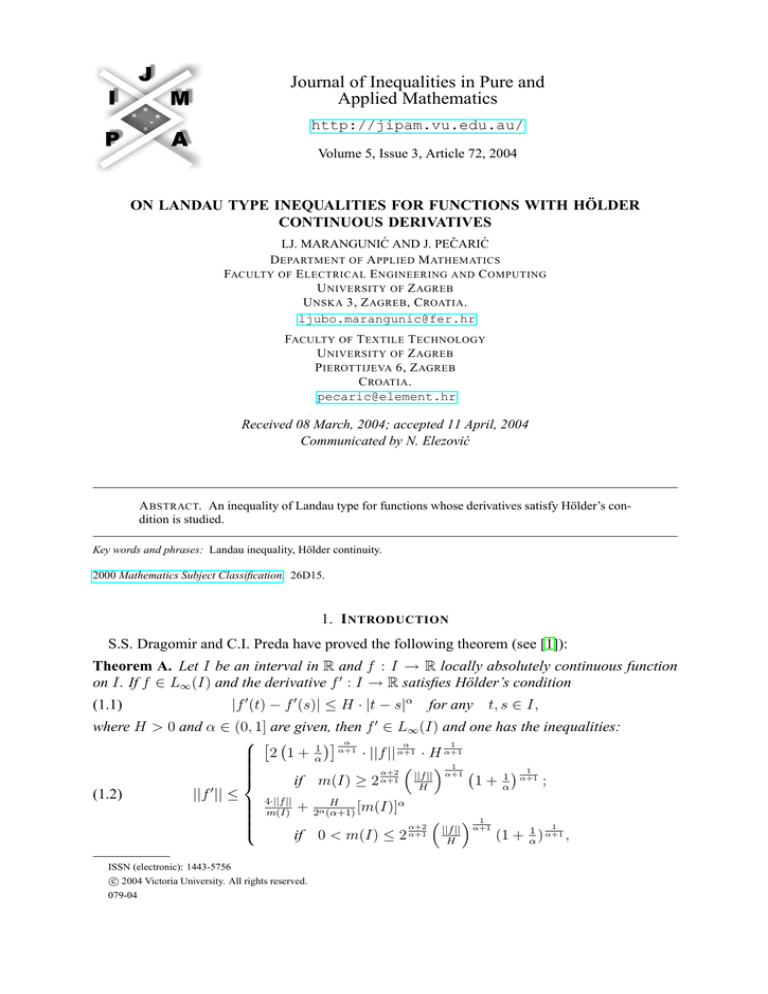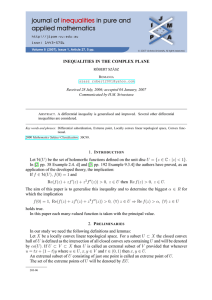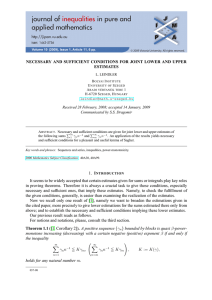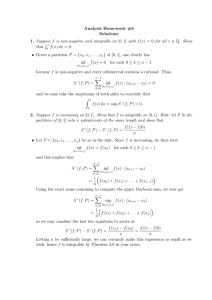
Journal of Inequalities in Pure and
Applied Mathematics
http://jipam.vu.edu.au/
Volume 5, Issue 3, Article 72, 2004
ON LANDAU TYPE INEQUALITIES FOR FUNCTIONS WITH HÖLDER
CONTINUOUS DERIVATIVES
LJ. MARANGUNIĆ AND J. PEČARIĆ
D EPARTMENT OF A PPLIED M ATHEMATICS
FACULTY OF E LECTRICAL E NGINEERING AND C OMPUTING
U NIVERSITY OF Z AGREB
U NSKA 3, Z AGREB , C ROATIA .
ljubo.marangunic@fer.hr
FACULTY OF T EXTILE T ECHNOLOGY
U NIVERSITY OF Z AGREB
P IEROTTIJEVA 6, Z AGREB
C ROATIA .
pecaric@element.hr
Received 08 March, 2004; accepted 11 April, 2004
Communicated by N. Elezović
A BSTRACT. An inequality of Landau type for functions whose derivatives satisfy Hölder’s condition is studied.
Key words and phrases: Landau inequality, Hölder continuity.
2000 Mathematics Subject Classification. 26D15.
1. I NTRODUCTION
S.S. Dragomir and C.I. Preda have proved the following theorem (see [1]):
Theorem A. Let I be an interval in R and f : I → R locally absolutely continuous function
on I. If f ∈ L∞ (I) and the derivative f 0 : I → R satisfies Hölder’s condition
(1.1)
|f 0 (t) − f 0 (s)| ≤ H · |t − s|α
for any
t, s ∈ I,
0
where H > 0 and α ∈ (0, 1] are given, then f ∈ L∞ (I) and one has the inequalities:
α
α+1
α
1
1
· ||f || α+1 · H α+1
2
1
+
α
1
α+1
1
α+2
||f ||
1 α+1
α+1
;
1
+
if m(I) ≥ 2
α
H
(1.2)
||f 0 || ≤
4·||f ||
H
+ 2α (α+1)
[m(I)]α
m(I)
1
α+1
α+2
1
(1 + 1 ) α+1 ,
if 0 < m(I) ≤ 2 α+1 ||f ||
H
ISSN (electronic): 1443-5756
c 2004 Victoria University. All rights reserved.
079-04
α
2
L J . M ARANGUNI Ć AND J. P E ČARI Ć
where || · || is the ∞-norm on the interval I, and m(I) is the length of I.
In our paper we shall give an improvement of this theorem.
2. M AIN R ESULTS
Theorem 2.1. Let I be an interval and f : I → R function on I satisfying conditions of
Theorem A. Then f 0 ∈ L∞ (I) and the following inequlities hold:
α
α
1
2 1 + α1 α+1 · ||f || α+1 · H α+1
1
α+1
1
1
||f ||
1 α+1
α+1
1
+
;
if m(I) ≥ 2
H
α
(2.1)
||f 0 || ≤
2||f ||
H
+ α+1
[m(I)]α
m(I)
1
α+1
1
1
if 0 < m(I) ≤ 2 α+1 ||fH||
1 + α1 α+1 ,
where || · || is the ∞-norm on the interval I, and m(I) is the length of I.
In our proof and in the subsequent discussion we use three lemmas.
Lemma 2.2. Let a, b ∈ R, a < b, α ∈ (0, 1]. Then the following inequality holds:
(2.2)
(b − x)α+1 + (x − a)α+1 ≤ (b − a)α+1 ,
∀x ∈ [a, b].
Proof. Consider the function y : [a, b] → R given by:
y(x) = (b − x)α+1 + (x − a)α+1 .
We observe that the unique solution of the equation
y 0 (x) = (α + 1) [(x − a)α − (b − x)α ] = 0
is x0 = a+b
∈ [a, b]. The function y 0 (x) is decreasing on (a, x0 ) and increasing on (x0 , b). Thus,
2
the maximal values for y(x) are attained on the boundary of [a, b] : y(a) = y(b) = (b − a)α+1 ,
which proves the lemma.
A generalization of the following lemma is proved in [1]:
Lemma 2.3. Let A, B > 0 and α ∈ (0, 1]. Consider the function gα : (0, ∞) → R given by:
A
(2.3)
gα (λ) = + B · λα .
λ
1
A α+1
Define λ0 := αB
∈ (0, ∞). Then for λ1 ∈ (0, ∞) we have the bound
A
if 0 < λ1 < λ0
λ1 + B · λα1
(2.4)
inf gα (λ) =
α
1
α
λ∈(0,λ1 ]
(α + 1)α− α+1 · A α+1 · B α+1 if λ1 ≥ λ0 .
Proof. We have:
A
+ α · B · λα−1 .
λ2
1
A α+1
The unique solution of the equation gα0 (λ) = 0, λ ∈ (0, ∞), is λ0 = αB
∈ (0, ∞). The
function gα (λ) is decreasing on (0, λ0 ) and increasing on (λ0 , ∞). The global minimum for
gα (λ) on (0, ∞) is:
1
α
α
α
1
αB α+1
A α+1
(2.5)
gα (λ0 ) = A
+B
= (α + 1)α− α+1 · A α+1 · B α+1 ,
A
αB
gα0 (λ) = −
J. Inequal. Pure and Appl. Math., 5(3) Art. 72, 2004
http://jipam.vu.edu.au/
O N L ANDAU T YPE I NEQUALITIES FOR F UNCTIONS. . .
3
which proves (2.4).
Lemma 2.4. Let A, B > 0 and α ∈ (0, 1]. Consider the functions gα : (0, ∞) → R and
hα : (0, ∞) → R defined by:
gα (λ) = Aλ + B · λα
(2.6)
h (λ) = 2A + B λα .
α
λ
2α
Define λ0 :=
A
αB
1
α+1
(2.7)
∈ (0, ∞). Then for λ1 ∈ (0, ∞) we have:
inf gα (λ) <
λ∈(0,λ1 ]
inf gα (λ) =
λ∈(0,λ1 ]
inf hα (λ) if
0 < λ1 < 2λ0
inf hα (λ) if
λ1 ≥ 2λ0 .
λ∈(0,λ1 ]
λ∈(0,λ1 ]
Proof. In Lemma 2.3, we found that the global minimum for gα (λ) is obtained for λ = λ0 .
Similarly we find that the global minimum for hα (λ) is obtained for λ = 2λ0 , and its value is
equal to the minimal value of gα (λ), i.e. hα (2λ0 ) = gα (λ0 ).
The only solution of equation gα (λ) = hα (λ), λ ∈ (0, ∞), is:
A
λS =
B(1 − 2−α )
1
α+1
,
and we can easily check that λ0 < λS < 2λ0 . Thus, for λ1 < λ0 we have gα (λ1 ) < hα (λ1 ) and
inf gα (λ) < inf hα (λ), and the rest of the proof is obvious.
λ∈(0,λ1 ]
λ∈(0,λ1 ]
Proof of Theorem 2.1. Now we start proving our theorem using the identity:
Z x
0
(2.8)
f (x) = f (a) + (x − a)f (a) +
[f 0 (s) − f 0 (a)]ds;
a, x ∈ I
a
or, by changing x with a and a with x:
Z
0
a
f (a) = f (x) + (a − x)f (x) +
(2.9)
[f 0 (s) − f 0 (x)]ds;
a, x ∈ I.
[f 0 (s) − f 0 (x)]ds;
b, x ∈ I.
x
Analogously, we have for b ∈ I:
Z
0
f (b) = f (x) + (b − x)f (x) +
(2.10)
b
x
From (2.9) and (2.10) we obtain:
(2.11)
b
Z
0
f (b) − f (a) = (b − a)f (x) +
x
[f 0 (s) − f 0 (x)]ds
Z x
+
[f 0 (s) − f 0 (x)]ds;
a, b, x ∈ I
a
and
(2.12)
f (b) − f (a)
1
f (x) =
−
b−a
b−a
0
J. Inequal. Pure and Appl. Math., 5(3) Art. 72, 2004
Z
x
b
1
[f (s) − f (x)]ds −
b−a
0
0
x
Z
[f 0 (s) − f 0 (x)]ds.
a
http://jipam.vu.edu.au/
4
L J . M ARANGUNI Ć AND J. P E ČARI Ć
Assuming that b > a we have the inequality:
Z
|f (b) − f (a)|
1 b 0
0
0
(2.13)
|f (x)| ≤
+
|f
(s)
−
f
(x)|ds
b−a
b−a x
Z
1 x 0
0
.
+
|f
(s)
−
f
(x)|ds
b−a a
Since f 0 is of α − H Hölder type, then:
Z b
Z b
0
0
α
(2.14)
|f (s) − f (x)|ds ≤ H · |s − x| ds
x
x
Z
=H
b
(s − x)α ds
x
=
(2.15)
Z
a
x
H
(b − x)α+1 ;
α+1
b, x ∈ I, b > x
Z x
α
|f (s) − f (x)|ds ≤ H · |s − x| ds
Z xa
=H
(x − s)α ds
0
0
a
H
=
(x − a)α+1 ;
α+1
a, x ∈ I, a < x.
From (2.13), (2.14) and (2.15) we deduce:
(2.16) |f 0 (x)| ≤
|f (b) − f (a)|
b−a
H
+
[(b − x)α+1 + (x − a)α+1 ];
(b − a)(α + 1)
a, b, x ∈ I, a < x < b.
Since f ∈ L∞ (I) then |f (b) − f (a)| ≤ 2 · ||f ||. Using Lemma 2.2 we obviously get that:
(2.17)
|f 0 (x)| ≤
2||f ||
H
+
(b − a)α ;
b−a α+1
a, b, x ∈ I, a < x < b.
Denote b − a = λ. Since a, b ∈ I, b > a, we have λ ∈ (0, m(I)), and we can analyze the
right-hand side of the inequality (2.17) as a function of variable λ. Thus we obtain:
(2.18)
|f 0 (x)| ≤
2||f ||
H α
+
λ = gα (λ)
λ
α+1
for x ∈ I and for every λ ∈ (0, m(I)).
Taking the infimum over λ ∈ (0, m(I)) in (2.18), we get:
|f 0 (x)| ≤
(2.19)
inf
λ∈(0,m(I))
gα (λ).
If we take the supremum over x ∈ I in (2.19) we conclude that
(2.20)
sup |f 0 (x)| = ||f 0 || ≤
x∈I
inf
λ∈(0,m(I))
gα (λ).
Making use of Lemma 2.3 we obtain the desired result (2.1).
J. Inequal. Pure and Appl. Math., 5(3) Art. 72, 2004
http://jipam.vu.edu.au/
O N L ANDAU T YPE I NEQUALITIES FOR F UNCTIONS. . .
5
1
h
i α+1
Remark 2.5. Denote λ0 = 2 1 + α1 ||fH||
. Comparing the results of Theorem A and
Theorem 2.1 we can see that in the case of m(I) ≥ 2λ0 the estimated values for ||f 0 || in both
theorems coincide. If 0 < m(I) < 2λ0 the estimated value for ||f 0 || given by (2.1) is better than
the one given by (1.2). Namely, using Lemma 2.4 we have:
H
4||f ||
H
2||f ||
(2.21)
+
[m(I)]α <
+ α
[m(I)]α ; m(I) ∈ (0, λ0 ]
m(I) α + 1
m(I) 2 (α + 1)
and
α
α+1
α
1
H
4||f ||
1
+ α
[m(I)]α ; m(I) ∈ [λ0 , 2λ0 ).
· ||f || α+1 · H α+1 <
(2.22) 2 1 +
m(I) 2 (α + 1)
α
Remark 2.6. Let the conditions of Theorem 2.1 be fulfilled. Then a simple consequence of
(2.11) is the following inequality:
H |(b − a)f 0 (x) − f (b) + f (a)| ≤
(b − x)α+1 + (x − a)α+1 ; a, b, x ∈ I, a < x < b.
α+1
This result is an extension of the result obtained by V.G. Avakumović and S. Aljančić in [2]
(see also [3]).
R EFERENCES
[1] S.S. DRAGOMIR AND C.J. PREDA, Some Landau type inequalities for functions whose derivatives
are Hölder continuous, RGMIA Res. Rep. Coll., 6(2) (2003), Article 3. ONLINE [http://rgmia.
vu.edu.au/v6n2.html].
[2] V.G. AVAKUMOVIĆ AND S. ALJANČIĆ, Sur la meilleure limite de la dérivée d’une function assujetie à des conditions supplementaires, Acad. Serbe Sci. Publ. Inst. Math., 3 (1950), 235–242.
[3] D.S. MITRINOVIĆ, J.E. PEČARIĆ AND A.M. FINK, Inequalities Involving Functions and Their
Integrals and Derivatives, Kluwer Academic Publishers, Dordrecht, Boston, London, 1991.
J. Inequal. Pure and Appl. Math., 5(3) Art. 72, 2004
http://jipam.vu.edu.au/












